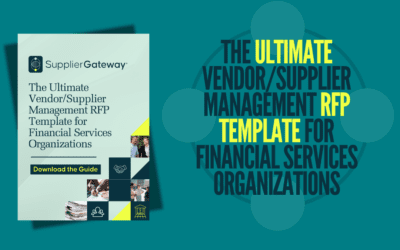
When starting out on developing your company’s supplier diversity program policy and statement, it’s essential to outline and understand several key elements.
You’ll want to understand:
- What the purpose of your supplier diversity program is
- What the program’s goals are
- How you plan to achieve those goals
Having a clear and concise supplier diversity policy will encourage buy-in across departments and with leadership, act as a guide for your supplier diversity team, and also help to build awareness regarding your supplier diversity program from both the public and suppliers themselves. This policy will also act as a guide for suppliers, helping them manage expectations around your company and its current needs.
Below are four actionable steps to guide you through the process of developing your company’s supplier diversity policy.
1. State the Purpose of Your Supplier Diversity Program
Why is your company interested in supplier diversity, and what is your company hoping to achieve by having a supplier diversity program? Here are some common answers to these questions:
- Increasing supply chain resiliency and strength
- Finding the best suppliers by increasing competition and encouraging innovation
- Promoting diversity – it’s the right thing to do
- Creating positive economic impact on the local economy
Make sure you’re secure in the reasoning behind your purpose. Include pertinent information in your supplier diversity policy that reinforces your reasoning and best explains your company’s rationale for establishing a supplier diversity program. This makes creating goals and initiatives a lot easier and more cohesive overall.
2. Define What Diversity Means to Your Company and Your Supplier Diversity Program
Leadership, stakeholders, and suppliers themselves will need to know what diversity means in regards to your specific supplier diversity program. These parameters will specify what diversity categories count towards your diverse spend goals. Decide what diversity categories your program will track, and make sure those categories are listed in your supplier diversity policy.
Here are some commonly tracked diversity categories:
- Minority-owned businesses
- Woman-owned businesses
- LGBTQ-owned businesses
- Veteran-owned businesses
- Disability-owned businesses.
For a complete list of small and diverse business categories that your business can track, see this post about supplier diversity certifications or this glossary of supplier diversity terms.
You’ll also need to decide whether or not you’ll require diverse suppliers to be certified by a third-party certification body. Many organizations require suppliers to be certified by third-parties in order to verify their diversity spends, but there are also cases where suppliers may self certify. Programs that report to government agencies like the Small business Administration (SBA) will need to be certified through the SBA’s certification program. Be up-front about what certifications your business will accept.
3. Develop Goals for Your Program
We all know how difficult it is to work towards a goal that hasn’t been stated or quantified. Your supplier diversity policy will need to include goals that guide your company’s supplier diversity program towards results.
Certain goals will have tangible results that are easy to track and measure, like increasing diversity spend by a certain percentage or dollar amount. If you’re interested in creating a positive economic impact on your local economy, your company can pledge to spend a certain percentage with local-to-you suppliers.
Less quantifiable goals for your company’s supplier diversity program might look like increasing supplier resiliency, driving company innovation, and increasing company sustainability.
No matter what goals you choose for your supplier diversity program, make sure they are clearly understood, specific, measurable, and attainable.
The most difficult part of setting goals is often the uncertainty about what constitutes a reasonable goal. One way to get a sense of reasonableness is to benchmark against other organizations. Ideally your benchmarks should be against organizations in a similar situation, market and size as you – but seeing what other industries are doing can also provide some insight into what’s possible.
4. Design and Implement Programs to Reach Your Supplier Diversity Goals
Once you’ve developed goals for your supplier diversity program, it’s time to figure out how to reach them. Determine the initiatives and programs necessary for your company to reach stated goals and include these in your supplier diversity policy. This will let suppliers know about opportunities with your company and act as guidance for your supplier diversity team in developing future initiatives.
Lots of companies make use of a supplier registration portal that allows diverse suppliers to register with the company. This helps tremendously with diverse supplier management. Supplier Diversity Software helps your company track multi-tier spending, keeps your data in order, and keeps your company up-to-date regarding any compliance issues with your suppliers.
Joining local chambers of commerce builds credibility in your local community while giving your company access to smaller, diverse suppliers. Developing relationships with national diverse supplier councils will help your company engage a larger variety of suppliers, making your diversity goals easier to reach.
Remember: your supplier diversity program policy should act as an informational guideline that keeps stakeholders, leadership, the public, and suppliers up-to-date regarding the goals of your supplier diversity program. The supplier diversity policy should also lay the groundwork for strategies that will help your company achieve the program’s goals.
As your supplier diversity program grows and changes, so should your policy, so be sure to keep your supplier diversity policy updated.












